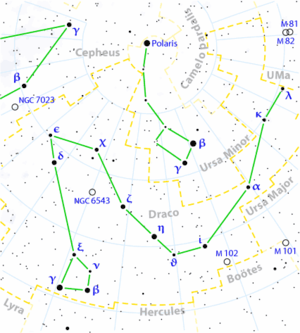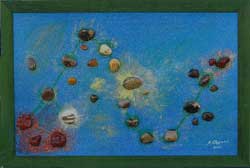|
|
Draco ( Latin: dragon) is a far northern constellation that is circumpolar for many northern hemisphere observers. It is one of the 88 modern constellations, and is also one of the 48 constellations listed by Ptolemy. Notable features Eltanin: brightest star in Draco constellation One of the deep-sky objects in Draco is the Cat's Eye Nebula (NGC 6543), a planetary nebula that is said to look like a blue disc. There are several faint galaxies in Draco, one of which is the lenticular galaxy NGC 5866, sometimes considered to be Messier Object 102. Mythology Among the earliest of human records written, the ancient Egyptians identified this constellation as Tawaret, the goddess of the northern sky in their pantheon of deities. Considered as ever-vigilant because the constellation never set, she was depicted a fierce protective goddess whose body was a composite of crocodile, human, lioness, and hippopotamus parts. There are a number of other myths behind the constellation. The Greeks named it Draco, due to its resemblance to a dragon [1], although alternative interpretations exist, such as the legend of the Mother Camels. In the most famous of the myths, Draco represents Ladon, the hundred-headed dragon who guarded the golden apples of the Hesperides. The eleventh of The Twelve Labours of Heracles was to steal the golden apples. He put Ladon to sleep with music, allowing him to freely take the golden apples. According to the legend, Hera later placed the dragon in the sky as the constellation Draco. Due to its position and nearby constellations in the zodiac sign of Libra (i.e. Ursa Major, Ursa Minor, and Boötes), the group of constellations can be seen to tell the tale of the eleventh labour. In another Greek legend, Draco represents the dragon killed by Cadmus before founding the city of Thebes, Greece. In a third legend, it represents the dragon that guarded the Golden Fleece and was killed by Jason. The fact that the stars of this circumpolar constellation never set plays an important part in its mythologies. References * Ian Ridpath and Wil Tirion (2007). Stars and Planets Guide Links * The Deep Photographic Guide to the Constellations: Draco
Retrieved from "http://en.wikipedia.org/"
|
|
||||||||||||||||||||||||||||||||||||||||||||||||||||

